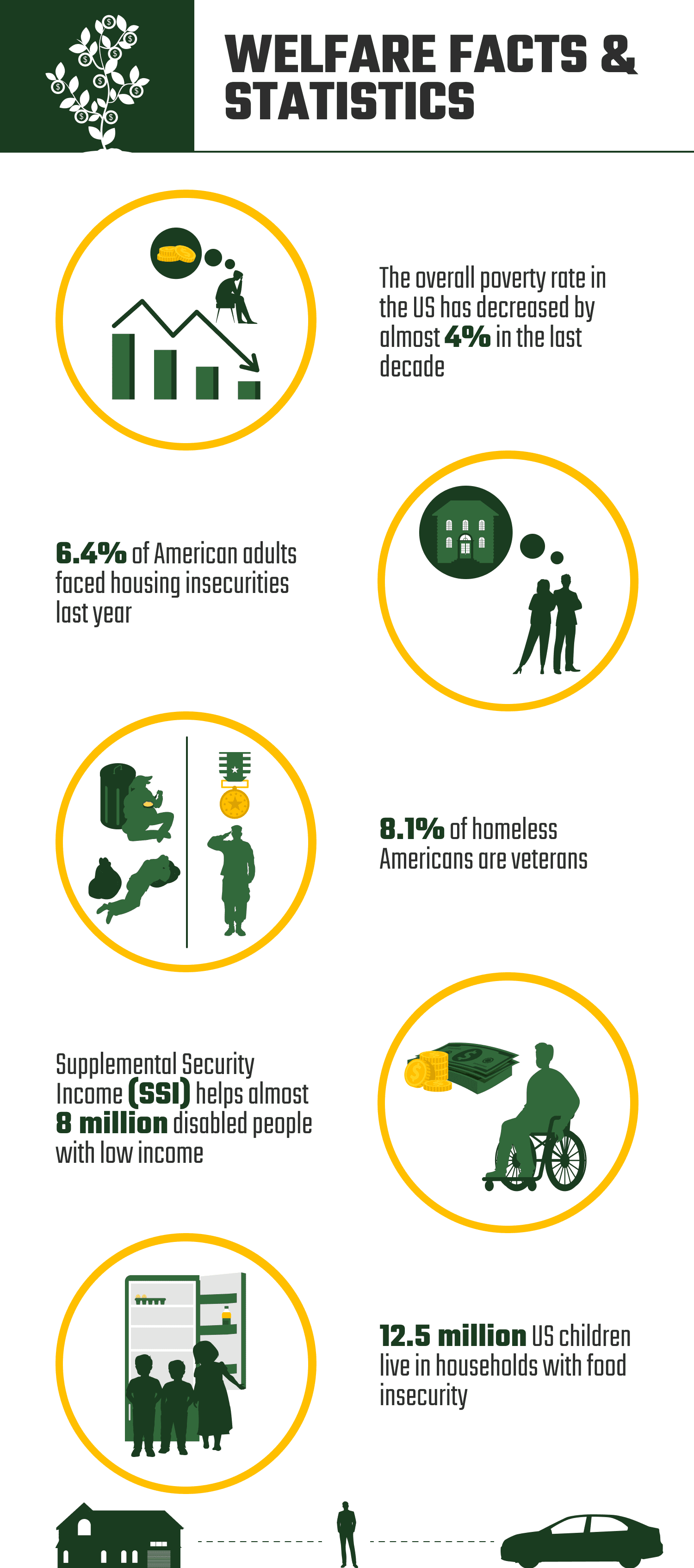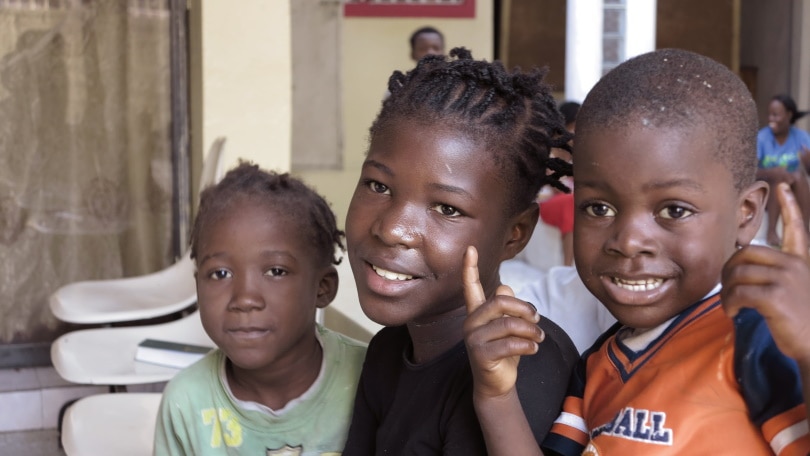13 Welfare Statistics & Facts to Know in 2025
-
Ed Malaker
- Last updated:

Note: This article’s statistics come from third-party sources and do not represent the opinions of this website.
If you are interested in income and the distribution of wealth in America, one of the best ways to get information is to look at recent welfare statistics to see how many people require help from the government. If you are interested in learning more about this fascinating topic, keep reading as we present you with several welfare facts that will help you be better informed.
Click below to jump ahead:
The 13 Welfare Statistics and Facts
- The poverty rate decreased from 2010 to 2020.
- 6.4% of American adults faced housing insecurities in late 2021.
- Black children are less likely to receive assistance than white or Latino children.
- 8.1% of homeless Americans are veterans.
- Medicaid provides one in five Americans with healthcare coverage
- SSI helps almost 8 million disabled people with low income.
- Most Americans believe that too many people are dependent on financial aid.
- Fewer people had problems paying bills in 2021 than in 2020.
- Middle-class families receive an average of $20,700 in government assistance.
- 12.5 million children live in households with food insecurity.
- Twenty states and the District of Columbia increased the benefit levels of TANF since 2020.
- SNAP helps 1.2 million low-income veterans.
- Earned Income Tax Credit helped lift 5.6 million people out of poverty in 2018.

Welfare Statistics
1. The poverty rate decreased from 2010 to 2020.
(USA Facts)
The overall poverty rate in the United States decreased from 15.1% in 2010 to 11.4% in 2020. Much of the decrease was in the Black population, where it fell from 27.4% to 19.5%. Another large change for the better was experienced by the Hispanic population, where the poverty rate fell from 26.5% to 17%.

2. 6.4% of American adults faced housing insecurities in late 2021.
(USA Facts)
In December 2021, 6.4% of American adults said that they weren’t sure if they would make next month’s rent payment and feared that they would have nowhere to live.
3. Black children are less likely to receive assistance than white or Latino children.
(Center on Budget and Policy Priorities)
Reports show that racist policies make it more difficult for Black children to receive government assistance from programs like Temporary Assistance for Needy Families (TANF) than white or even Latino families. These statistics lead many people to believe that it’s time for these programs to receive updates so they can help a broader range of children.

4. 8.1% of homeless Americans are veterans.
(Center on Budget and Policy Priorities)
Some reports show that up to 8.1% of the homeless people in America are retired veterans. Many have a severe disability that makes it difficult for them to find work, and many find it difficult to reintegrate into society after serving in the military, so it can be difficult for them to cover their expenses and maintain proper living quarters.
5. Medicaid provides one in five Americans with healthcare coverage.
(KFF)
Medicaid helps provide healthcare coverage and long-term care for one in five Americans, meaning that help is offered to more than 75 million low-income families every year.

6. SSI helps almost 8 million disabled people with low income.
(The Balance)
Supplemental Security Income (SSI) is helping 7.9 million people as of January 2021 cover their expenses by providing them with $585.53 per month. Many of the recipients are blind or have another serious disability, like kidney or heart disease.
7. Most Americans believe that too many people are dependent on financial aid.
(The Balance)
A survey conducted in 2018 found that 61% of Americans believe that too many people are dependent on financial aid. However, many people against financial aid do not realize that they themselves receive it through the government’s many programs that help reduce their end-of-the-year taxes, mortgage payments, etc.

Welfare Facts
8. Fewer people had problems paying bills in 2021 than in 2020.
(USA Facts)
Reports show that 37.5% of people expressed problems paying bills in 2020. That number fell 7% to 30.5% in 2021. The Black population found it most difficult to pay bills but also experienced the largest decline in complaints. The Hispanic population was also better able to reduce the number of people who had difficulty paying their bills than Asian or white communities.
9. Middle-class families receive an average of $20,700 in government assistance.
(USA Facts)
Middle-class families receive an average of $20,700 in government assistance. This money comes from programs like food stamps, Social Security, and Medicare.

10. 12.5 million children live in households with food insecurity.
(American Journal of Public Health)
12.5 million children live in households where the parents are unsure that they will have the funds required to purchase enough food to feed the family, despite help from programs like Supplemental Nutrition Assistance Program (SNAP), which provide more than $65 billion in assistance.
11. Twenty states and the District of Columbia increased the benefit levels of TANF since 2020.
(Center on Budget and Policy Priorities)
Twenty states and the District of Columbia increased the benefit levels for low-income families receiving assistance from TANF since July 2020. Seven of these states, including Massachusetts, Mississippi, Rhode Island, Tennessee, and Virginia, increased aid by 10%. For some states, this increase was the first in more than 20 years, but many people point out that the policies need to be adjusted to include more Black children to have the greatest impact.

12. SNAP helps 1.2 million low-income veterans.
(Center on Budget and Policy Priorities)
SNAP is the current version of food stamps, and it helps more than 1.2 million low-income veterans receive the food that they need to survive. Every state has thousands of these veterans, with Florida containing the largest number with more than 100,000. Other states with many low-income veterans include Texas and California, both of which have 90,000 or more.
13. Earned Income Tax Credit helped lift 5.6 million people out of poverty in 2018.
(The Balance)
Earned Income Tax Credit (EITC) is a government program that provides a tax credit to low-income families that make less than $53,330 per year. It provides them with up to almost $6,000 in reductions on their taxes, and more than 22 million individuals and families are able to save at least a small amount of money. It also lifted 5.6 million people out of poverty in 2018, many of which were children.

Why Are So Many People Against Welfare?
Many programs, like the old food stamps program, were easy to take advantage of and misuse, which resulted in rules and regulations that were not that effective, and many people were still not getting the help that they needed. Many welfare programs have been updated, and the fraud rate for food stamps (now EBT cards) is less than 1.5% today, but the misconception still exists. Also, many people are against welfare because it increases their taxes. Taxpayers get upset if it seems like people are abusing the system, driving up their costs. However, many people require these programs to survive and are in no way misusing the system. (TIME)
Does Welfare Help People?
Many of the facts and statistics on this list show that welfare does indeed help millions of people every year receive the medical assistance that they need and the extra funds required to help them pay their bills. Many people were lifted out of poverty through government programs in the last few years, and more people are comfortable paying their bills this year than they were last year. That said, many programs do need to be updated to make sure money is spread evenly to the people who need it, regardless of race or other factors.
Conclusion
While most government programs could be better, they help many people visit the doctor, keep their children fed, and pay their rent each year. The programs go far beyond SNAP and Medicaid and include many other programs, like SSI and EITC, that help working families. These government programs can also help you pay your mortgage or insulate your home, so they even help homeowners and other people not enrolled in any other welfare programs. The only problem is that most need serious reforms to be more inclusive of different races.
Featured Image Credit: Piqsels
Contents
